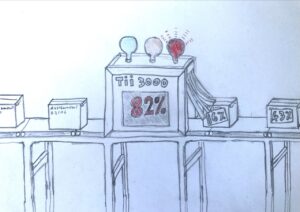Similarity or Plagiarism – It shouldn’t just be mechanical

I’ve had a lot of comments recently, within training sessions and through support calls regarding Turnitin, that have really opened my eyes to the misunderstanding of the tool – that it’s being used as a plagiarism checker with no thought of what the generated similarity score really means.
The kind of fear that a high similarity score puts into a student should be made into a horror film. It doesn’t help when students have been told you should be getting a score of under 11% for a submission by teaching staff.
So what’s the big deal about a high score anyway? How important is context?
Turnitin has a similarity checker tool that can be applied to an assessment drop-box. This tool checks for similarities in a submission by going through its own collated database, this database consists of a repository of work previously submitted to Turnitin and selected web pages from current and archived sources from the internet. The tool then flags the similarities with the assignment, and calculates an overall percentage score. The score represents how much of the assignment text matches other sources.
It’s perfectly natural for an assignment to match against something on the database. For example, if quotes have been used a match will occur. Industry standard terms and explanations will also flag a similarity and increase the score. In addition, some assignments will want you to include the question into your paper, creating multiple similarities that all add up.
Controversially, there has even been an instance where a student has received a 100% similarity score. This occurred due to a group project paper being submitted twice by two different students from the same group. The first submission would have generated a score but the second submission detected the 100% similarity to the first submission causing alarm to the second student. In reality, the group assignment should have only been submitted by one student, but this does highlight what could happen when the scores are reviewed out of context.
How can we change this perception?
Turnitin says:
Turnitin does not check for plagiarism in a piece of work. Instead, we will check a student’s work against our database, and if there are instances where a student’s writing is similar to, or matches against, one of our sources, we will flag this for you to review
A marker can see the list of any similarities within the assignment and their sources. They can then make a decision on whether plagiarism has taken place. Markers are then able to filter these similarities from the list effectively bringing down the score after their review.
We (Learning Teaching and Web services) say:
Staff and students should understand that similarity reports do not say whether plagiarism has taken place; the report simply highlights sections of the submitted text that match other sources. It remains an academic decision as to what the similarity means and what happens as a consequence.
The similarity report does give Turnitin a bad reputation compared to its other marking features that are often over-looked. One of these is ‘QuickMarks’ which allows you to apply preloaded sets of comments to a submission; you can customize these sets, and you can even add your own QuickMarks.
Another tool is the ‘Feedback Summary’; here you can add an overall comment with the ability to add a voice recording.
Finally, there is the ‘Rubric/form’ where you can apply a marking scheme or rubric that is used by a School, programme or course.
I have been more than happy to put students at ease and setting things straight for markers within our training sessions and through my replies to support calls. We encourage teaching staff to allow students to have a practice submission drop-box so students can see what to expect when it comes to submitting work online and viewing the similarity report. We urge staff to explain what Turnitin is, why it is being used for the assignment and how it works. Hopefully, this will increase the understanding of what Turnitin is and the best way to use it as a marking and feedback tool.
If you would like to know more about Turnitin and the use of its tools you can sign up to our training course ‘Learn: Online assessment and feedback using Turnitin Feedback Studio’ via MyEd (link opens in a new window).

Similarity or Plagiarism – It shouldn’t just be mechanical.
(Designed and drawn by Alan Hamilton)
(Designed and drawn by Alan Hamilton)




Recent comments